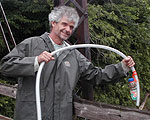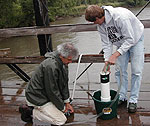By Erin Galbally
Minnesota Public Radio
July 11, 2002
The summer time is breeding time for zebra mussels. They're an exotic pest that's spreading through Minnesota waterways. They breed so rapidly they can overwhelm wildlife and choke water supply systems. Right about now millions of microscopic larvae are headed down the Mississippi River. This year scientists from St. Paul to St. Louis are studying how and where the pest is spreading by collecting samples from the Mississippi and its tributaries.
| |
|
|
|
||
The fast moving Zumbro River is always muddy. Researchers standing on Spooner Bridge lower a long plastic hose into the rushing water. Weighted down by a bottle filled with small rocks, the hose nozzle floats just under the surface.
Mike Davis works for the Minnesota Department of Natural Resources. He's in charge of testing this Mississippi River tributary for zebra mussels.
Davis works away at a hand pump sucking river water up the length of the plastic hose. The water passes through a filter and into a green bucket.
Zebra mussels are fairly new to the tributary. They turned up in Lake Zumbro two years ago. It was the first infested inland lake in the state. Since water from the lake flows into Zumbro River which in turn flows into the Mississippi, the DNR designated the waterway as a test site.
Zebra mussels monopolize the food and oxygen native species need to survive. Once they're in a spot its nearly impossible to get rid of them. In fact they spread like a carpet.
| |
|
|
|
||
Davis says the mussels made it into Lake Zumbro the same way they've made it out of the Great Lakes up the Mississippi River. Humans brought them.
"They can't move upstream unless someone helps them out like a boat or a barge or a bucket of water," explains Davis. "But once they're in the lake the larvae will flow out of the and into the river and into the next body of water."
The DNR is concerned Lake Zumbro may well become a major zebra mussel breeding ground. Davis says zebra mussels tend to congregate in a big lake and spread from there.
"Zebra mussels are best adapted to life in a lake rather than a river because they have this free floating larvae in the river and the larvae just goes eventually they would just flush themselves out," says Davis. "But because there's a lake involved they retain their population and constantly reseed the river."
The Minnesota DNR and similar agencies in other states along the Mississippi River are sampling now because water temperatures are rising. That's what triggers mussel reproduction.
Davis holds the styrofoam filter. He's assisted by intern Scott Noland.
"You want me to rinse this first? Like this?," says Davis to Noland.
Davis squirts water along the sides of the filter and Noland swooshes the tiny flecked remains into a container destined for the lab.
"So the little larvae should be rolling into the jar along with any other plankton that live in the river. Little microscopic critters," says Davis.
| |
|
|
|
||
Davis and Noland collect three samples from different spots along the bridge. After they send in samples they won't get the results for months. Eventually they'll get a reading of how many mussels per liter of river water. That will be compared and mapped along with dozens of other spots along and around the Mississippi River. The testing this year will continue for another two months as scientists try to build a more accurate picture of the zebra mussel problem.
More from MPR


